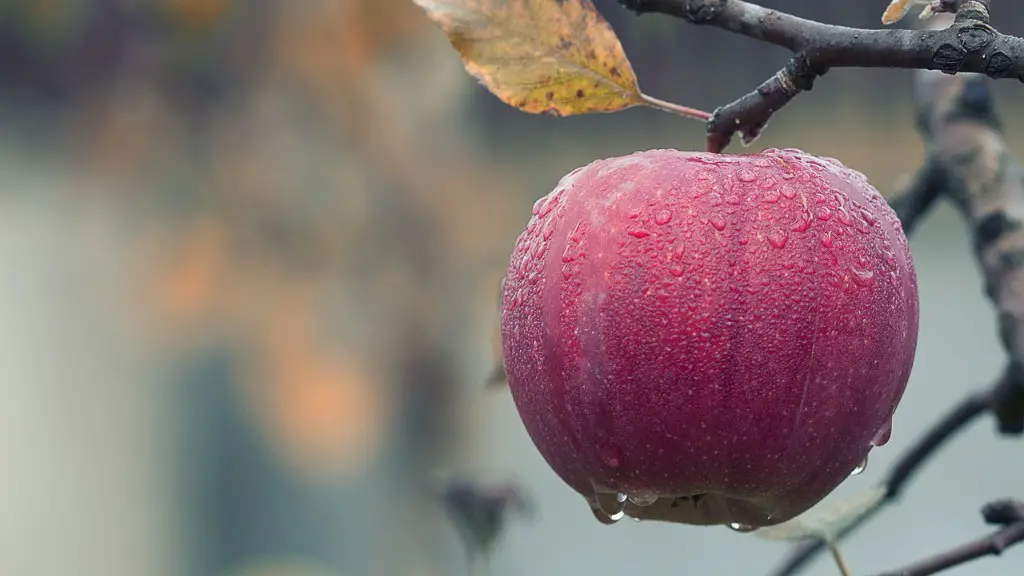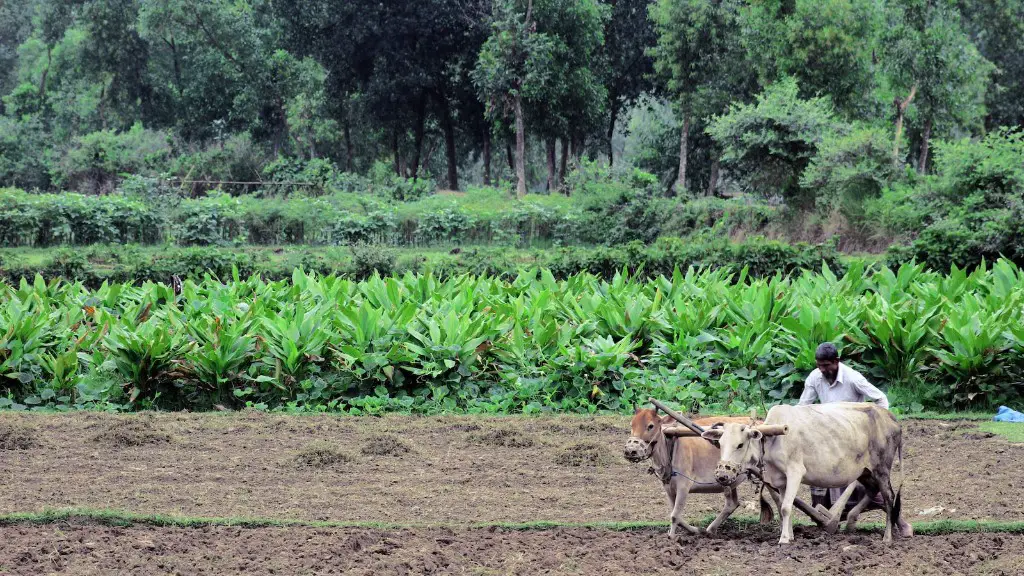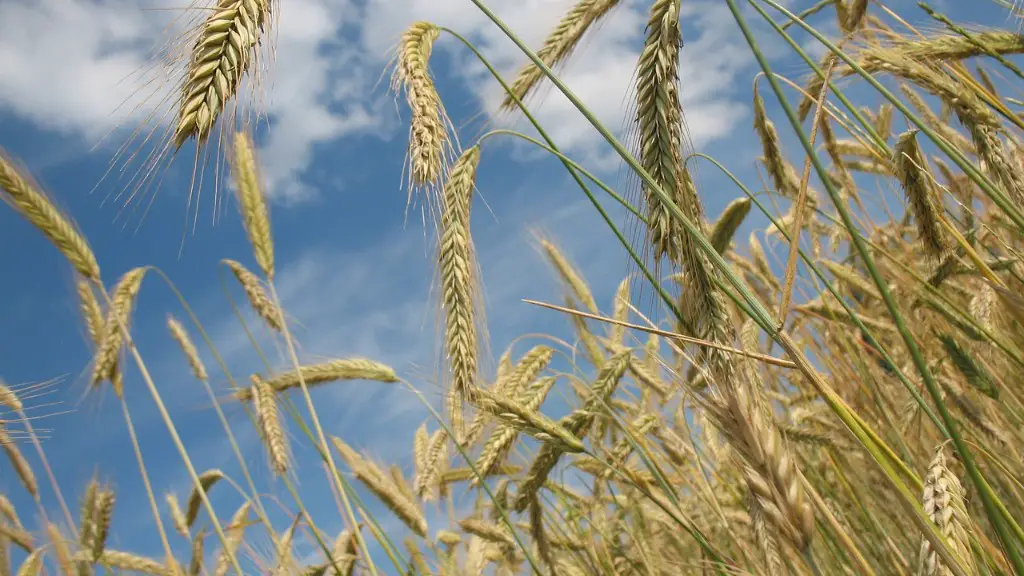Agricultural pollution of water is caused by a variety of factors, including animal waste, fertilizer and pesticide run-off, and soil erosion. Animal waste can contaminate water with bacteria, viruses, and parasites that can cause disease. Fertilizer and pesticide run-off can cause eutrophication, or an overgrowth of aquatic plants and algae, which can block sunlight and oxygen from reaching other aquatic creatures. Soil erosion can lead to sedimentation in waterways, which can clog fish gills and block sunlight and oxygen from reaching aquatic plants.
There are a few ways that agriculture can cause water pollution. One way is through the use of pesticides and herbicides. These chemicals can runoff into waterways and contaminate the water. Another way is through the improper disposal of livestock waste. This can also runoff into waterways and contaminate the water.
How does agriculture pollute water?
As water evaporates from the soil, it leaves behind any dissolved minerals, including salt. If this process occurs repeatedly in the same area, the salt concentration in the soil can build up to levels that are harmful to plants. Irrigation can help to remove this salt from the soil and prevent it from accumulating.
Livestock operations often produce large amounts of waste, which if not properly disposed, can threaten human health as well as contribute to excess nutrient problems in streams, rivers, lakes, and estuaries. Properly managed irrigation can help to remove these nutrients from the waste and prevent them from polluting surface water bodies.
Agricultural runoff is a major environmental issue. Poorly managed animal feeding operations, overgrazing, and overworking the land can all lead to agricultural runoff. This can cause serious water pollution problems. Poorly managed and ineffective application of pesticides, irrigation water, and fertilizer can also contribute to agricultural runoff.
How does agriculture affect ocean pollution
Most ocean pollution begins on land. When large tracts of land are plowed, the exposed soil can erode during rainstorms. Much of this runoff flows to the sea, carrying with it agricultural fertilizers and pesticides. Eighty percent of pollution to the marine environment comes from the land.
The erosion and transfer of soil particles and fine silt from agricultural land into waterways can have a significant impact on fish spawning and the amount of light that penetrates the water. This can interrupt ecological processes and lead to a loss of flow capacity within rivers, thereby enhancing flood risk.
What are the 3 main causes of water pollution?
Water pollution is a growing problem all over the world. There are many causes of water pollution, but the four main ones are: global warming, deforestation, rubbish and faecal water dumping, and fuel spillages.
Global warming is causing the water to heat up, which reduces its oxygen content. This is a huge problem for marine life, as they need oxygen to survive.
Deforestation is another big cause of water pollution. When trees are cut down, the soil is eroded and this can end up in rivers and lakes. This soil contains chemicals and pollutants which pollute the water.
Rubbish and faecal water dumping is another huge problem. This is when people dump their rubbish, or sewage, into rivers and lakes. This pollutes the water and can make it dangerous for people to drink.
Fuel spillages are also a big problem. When fuel is spilt into water, it pollutes it and can make it dangerous for people and animals.
Water pollution is a big problem because it can make water unsafe to drink, damage ecosystems, and hurt the economy. There are many different causes of water pollution, but some of the most common are industrial waste, marine dumping, sewage and wastewater, oil leaks and spills, agriculture, and global warming. To protect our water, we need to be aware of these causes and take steps to reduce or eliminate them.
What are 3 ways that agriculture can harm the environment?
Pesticides, fertilizers and other toxic farm chemicals can have a serious impact on the environment. They can poison fresh water, marine ecosystems, air and soil. They also can remain in the environment for generations. Many pesticides are suspected of disrupting the hormonal systems of people and wildlife. Fertilizer run-off impacts waterways and coral reefs.
Conventional farming is the main source of food for the world, but it has many negative impacts.
Large-scale, conventional farming focuses on intensive single crop production, mechanization, and depends on fossil fuels, pesticides, antibiotics, and synthetic fertilizers. While this system yields high production levels, it also contributes to climate change, pollutes air and water, and depletes soil fertility.
The heavy use of fossil fuels in conventional farming contributes to climate change, and the use of pesticides and synthetic fertilizers pollute air and water. Conventional farming also depletes soil fertility, which can lead to lower crop yields over time.
We need to find ways to farm that are more sustainable and have less negative impacts. We need to move away from heavy reliance on fossil fuels, reduce pesticide and fertilizer use, and find ways to improve soil fertility.
What are 7 major sources of water pollution
There are many sources of water pollution, but some of the most common include sewage, agricultural pollution, oil pollution, and radioactive substances. Sewage is waste water from domestic and industrial processes that can contain harmful bacteria and other contaminants. Agricultural pollution comes from various sources, including pesticide and fertilizer runoff, livestock waste, and soil erosion. Oil pollution can come from spills, leaks, and runoff from oil and gas production facilities. Radioactive substances can enter water sources through nuclear power plants and other facilities. River dumping is the discharge of pollutants into rivers, and marine dumping is the discharge of pollutants into the ocean.
Water pollution is caused by many different factors. One of the biggest causes is rapid urban development. As cities grow, they produce more and more waste. If this waste is not properly disposed of, it can pollute local water sources. Another major cause of water pollution is fertilizer run-off. When farmers use fertilizers on their crops, some of the fertilizer can be washed away by rain or irrigation. This can pollute rivers and lakes, making them unsafe for swimming or drinking. Oil spills are also a major cause of water pollution. When an oil tanker spills its cargo, the oil can pollute the water for miles around. This can kill marine life and make the water unsafe for human use. Chemical waste dumping is another common cause of water pollution. When companies dump their chemical waste into rivers or lakes, it can pollute the water and make it unsafe for people and animals. Radioactive waste discharge can also cause water pollution. When nuclear power plants discharge their waste into rivers or lakes, it can make the water unsafe for human use.
What is the largest contributor to water pollution?
Water pollution is a serious global problem. The main point sources of pollution to water are from sewage and waste water treatment, while for diffuse pollution, main sources are from farming and fossil fuel power plants (via the air). Water pollution affects both humans and the environment, and it is important to take steps to reduce this pollution.
Fluorine is a very important element in the environment, and it is found in many different ways. Fluoride is the most common way that it is found in nature, and it is very important for many different things. Arsenic is another very common metalloid that is found in the atmosphere, the hydrosphere, and the soil. There are other natural pollutants like manganese, uranium, radon, cesium, and lithium that are also very important for the environment.
What are the 4 major water pollutants
Water pollution is a growing problem all over the world. There are a variety of different types of water pollutants, which can be divided into four main categories: pathogens, organic materials, inorganic compounds, and macroscopic pollutants.
Pathogens are microscopic organisms that can cause disease in humans and animals. These include bacteria, viruses, and protozoa. Organic materials are biodegradable substances that come from plants and animals. Inorganic compounds are minerals or other chemicals that come from the earth. Finally, macroscopic pollutants are larger pieces of debris that can be seen with the naked eye, such as plastic bags or tires.
Water pollution is a serious problem because it can contaminate our drinking water, making it unsafe to consume. It can also harm aquatic life and damage ecosystems. Therefore, it is important to be aware of the different types of water pollutants and to take steps to reduce water pollution.
Water pollutants include chemicals, bacteria, parasites, and trash. These pollutants can come from many different sources, such as factories, sewage treatment plants, and even runoff from agricultural fields. Water pollution can have a devastating effect on the environment and human health, and it is therefore important to take steps to reduce the amount of water pollution that occurs.
What are examples of agricultural pollution?
The USGS regularly monitors agricultural contaminants in order to assess their impact on the environment. Nutrients, pesticides, and other pollutants can all have negative effects on ecosystems, and the USGS studies them in order to better understand and mitigate these impacts.
Pesticide runoff from agricultural operations can pose risks to aquatic life, fish-eating wildlife, and drinking water supplies. Pollutants from agricultural operations can also enter groundwater and degrade sources of drinking water. Human health impacts might occur as a result. The use of best management practices to minimize pesticide runoff can help protect water resources.
What are the three major agricultural pollutants
Agricultural air pollution is a major problem because it contributes to the greenhouse effect. Agrochemical runoff can also over-enrich bodies of water and cause eutrophication.
Agriculture is a major source of air pollution, contributing to the production of greenhouse gases and other harmful pollutants. Livestock account for a significant portion of agricultural emissions, with manure and fertilizer production being major contributors. In addition, crop burning and biomass burning are also significant sources of agricultural air pollution.
Warp Up
The main ways that agriculture causes water pollution are through the use of chemicals, such as fertilizers and pesticides, and through livestock farming.
Chemicals used in agriculture can pollute water resources in a number of ways. They can contaminate ground water, surface water, and the soil. They can also pollute the air.
Livestock farming is another major source of water pollution from agriculture. manure and other wastes from livestock can contaminate water resources.
Agriculture is responsible for a great deal of water pollution. The main culprits are pollutants from animal waste, pesticides, and fertilizer. These pollutants can contaminate groundwater, surface water, and soil. They can also cause problems for plants and animals, and make people sick.
The good news is that there are many things farmers can do to reduce water pollution from agriculture. They can use best management practices like Conservation Buffers, Nutrient Management, and Pest Management. They can also plant cover crops and practice no-till farming. These practices can go a long way towards protecting our water resources.





